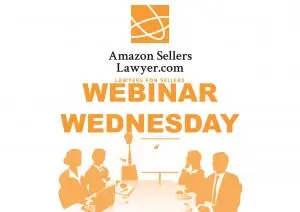How to Optimize your Amazon Listings
Amazon Listing Optimization – There’s one thing you might not have considered when it comes to selling your products on Amazon: images and bullet points in your listings.
Danny Carlson, founder of Kenji ROI hopped on Webinar Wednesday with CJ Rosenbaum of Amazon Sellers’ Lawyer to discuss how to optimize your listings using a couple of key strategies.
Carlson’s website, KenjiROI.com, helps Amazon Sellers create their own images for their products as well as with writing effective bullet points for listings. Carlson believes these two things are essential to not only getting more sales, but also to preventing complaints and even suspensions.
::: Watch the Webinar below :::
Amazon Listing Optimization – Images
Images are the single most important thing for your listing, according to Carlson. If you want to grab the customer’s attention, you have to have an effective “hero image,” or main image that a customer will first see on Amazon attached to your product.
“If people are scrolling on your competitors’ listings and they see: ‘customers who bought this item also bought…’ that’s the customer’s window into your products,” Carlson says. “So if that image sucks, it doesn’t matter how good the rest of your listing is, no one is going to see it. That’s why I say your image is the most important.”
People are always told not to judge a book by its cover, but it’s human nature to only become interested in something once you see an intriguing picture. Any author, musical artist, and even chef will tell you that presentation is everything. If you have bad presentation or a bad first impression, it doesn’t matter how good your product or service is; nobody is going to get far enough to find out how good it is.
So how do you create a good hero image that grabs the customer’s attention?
Carlson has some insight on that as well:
“It’s important in the hero image for your product to take up as much space in the image as possible, so there isn’t a lot of white space around the edge,” Carlson says. “Because people scrolling on the search results page, if you get a tiny thumbnail, it’s not going to help. If your products are bigger than everybody else’s, that’s definitely going to help.”
Carlson notes that it’s especially important to have your product take up as much of the image as possible for your customers who are shopping on the Amazon mobile app. The image is going to be even smaller on the mobile app. If the customer can’t see it on a desktop, then they definitely won’t see it on a phone. A customer isn’t going to have the patience to try zooming in on your picture if your competitors’ pictures are big enough to be seen on the app.
There are many different kinds of images beyond just the hero that are important to get right. Carlson refers to “lifestyle images,” which are pictures that show your product being used by a person in the real world. For example, if you sell oven mitts, your lifestyle image would show a model in a kitchen using oven mitts to bake a tray of cookies. Lifestyle images are important for a few reasons.
“So if you have a beach volleyball or something like that, if you show someone actually using a beach volleyball on the beach, the customer knows how big that ball is going to be,” Carlson says. “Because if you just have a picture on a white background, they might think it’s much bigger than it is or much smaller than it is. You’re probably going to get some two-star or one-star reviews just based on that. You can show a lot of information with a picture of something.”
If customers get an item that is disproportionately sized compared to their expectations, they might write up a complaint or give you a negative review. As readers of this blog well know, bad reviews spell trouble for Sellers trying to stay in business with Amazon.
If you’re interested in seeking professional help with your images, check out KenjiROI.com for some information on how to own your images.
“We do all of the photography here in Vancouver,” Carlson says. “Sellers ship us their products, we do all of the photography in the studio. We do the lifestyle photography with real models. We touch it up, do color corrections, add effects, and all of that stuff.”
The best part about getting images for your products through companies like these is you actually own those photos.
You can get your Amazon Sellers’ account suspended for using images that aren’t yours, that’s a copyright infringement.
“Taking your own images is absolutely vital,” Rosenbaum agrees. “What we do here, we write tons of non-legal Plans of Action for Sellers who either lost an ASIN or lost their account. The other half of the practice is dealing with Intellectual Property, which is copyright. The main copyright issue that you can’t do is you can’t use someone else’s image. You can’t scrape someone else’s picture, you can’t do a screenshot. You can’t copy and clean it up. That is a clear copyright violation.”
Using effective and professional images will not only get you more sales, but it will also keep you out of trouble in terms of copyrights.
Amazon Listing Optimization – Making the Most Out of Your Bullets
Another major factor for your listings are your bullet points. A lot of Sellers write theirs improperly, notes Carlson. It’s easy to do them wrong but it’s also important to get them right, and it might be simpler to do it correctly than you might think.
“With bullet points, it’s important to have brevity and to be super concise,” Carlson says. “That’s one problem I always see with listings is that people make them way too long. A lot of Sellers put on average 2-3 times more text than they need on there, when they could say the exact same thing in about two sentences.”
A lot of Sellers want to have longer bullet points because they want to make sure they get in enough key words to have their product show up on search results. But ultimately, that’s not what bullet points are for. They’re for convincing the customer to buy your product.
“Bullet points are the weakest section of the listing when it comes to weight for key words,” Carlson says. “We’ve never had a problem getting all of the search terms we want in a listing. That’s another mistake, is when people get caught up in trying to get way too many search terms in their listing.”
Make sure your bullet points include the most vital information that your customer needs to know about your product. Don’t get too cute with what you include in them. Just give the hard facts. Focus on the benefits of your product and what the customer will get out of your product.
Kenji ROI can also assist Sellers with writing effective bullet points for their products, which will help optimize your listing.
Amazon Listing Optimization – Conclusion
There’s always more to learn about making sure your listings are up to snuff. Never grow complacent with how your products look to your customers and do your due diligence to make sure you’re thinking like a customer when you list.
Carlson even suggests to pay attention to what your brain focuses on the next time you shop for a product on Amazon. What do you pay attention to? What kinds of things grab your attention and make you want to click on a product?
Focus on what your priorities are as a customer so you know what your priorities should be as a Seller.
Make sure to catch Webinar Wednesdays with Amazon Sellers’ Lawyer, where CJ Rosenbaum speaks to an expert in a field of online selling. The tips you learn might just help you become a more effective and profitable seller.
 Anders is a content creator for Rosenbaum Famularo, P.C., the law firm behind AmazonSellersLawyer.com.
Anders is a content creator for Rosenbaum Famularo, P.C., the law firm behind AmazonSellersLawyer.com.
Anders will be earning his degree in journalism from Hofstra and has five years of professional journalism experience. He has written for numerous online and print publications including SB Nation and The Hofstra Chronicle.
